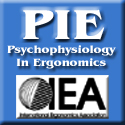About PIE

The purpose of PIE is to promote and advance the understanding of psychophysiological methods and their application to ergonomic environments through the interchange of knowledge and methodology in the behavioral, biological and physical sciences, and engineering disciplines.
BYLAWS of PIE
Psychophysiology in Ergonomics (PIE) has been founded as an interest group in 1993 at the 33rd Annual Meeting of the Society for Psychophysiological Research (SPR). In 1995, PIE became a technical group of the International Ergonomics Association (IEA). PIE has grown from the initial organizing committee of Wolfram Boucsein, John Stern, and Akihiro Yagi to a membership of 260 members worldwide. PIE became a formal organization by adopting a constitution on May 31, 1996.
PIE maintains a membership directory and an e-mail network for distributing information from and to members. PIE has sponsored several major conference symposia at meetings of SPR, IEA and the Human Factors and Ergonomics Society (HFES). In 1996, PIE sponsored a special issue of "Biological Psychology" edited by Anthony W.K. Gaillard, Wolfram Boucsein and John A. Stern. A special issue of "Ergonomics" edited by Wolfram Boucsein, Robert A. Henning and Stephen W. Porges was published in May 1998. A special issue of the "International Journal of Psychophysiology" edited by Akihiro Yagi, Wolfram Boucsein and Fumio Yamada was published in April 2001. A special section of "Human Factors" edited by Michael Trimmel, Nicola Wright and Richard W. Backs was published 2003. Akihiro Yagi edited a special issue on "Psychological Engineering - Psychophysiological Approaches - for "PSYCHOLOGIA" in June 2005. Michael Trimmel, Rob Henning and Stephen Fairclough edited the special issue in the Applied Ergonomics (AE) . Papers based on presentation at PIE2006 are published in this journal.
PIE holds autonomous biannual conferences, the objectives of which are to provide an international forum for the presentation of scientific work on the use of psychophysiological methods in the field of ergonomics and to foster the exchange of expertise among international scientists in this field.
